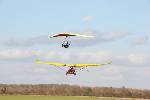Dr. Paul Robertson lectures at Cambridge University’s Engineering Department, and Paul Dewhurst serves as Director and Chief Flying Instructor at Flylight Airsports, Ltd. The two Pauls made simultaneous takeoffs March 1, 2009 in Britain’s first two electric aircraft. A third Paul, Welsh by name, acted as certification engineer for the effort.

Electric Dragonfly and Lazair hum quietly about the green fields of Sywell.
Dr. Robertson took to the skies in a Dragonfly hang glider powered by a Geiger/Eck 10kW motor/controller/propeller combination, while Dewhurst became skyborne in a Lazair ultralight propelled by a pair of Plettenberg Predator 12 kW (peak output) model airplane motors. This testbed in particular reflects Dr. Roberton’s studies toward the constuction of a sub-115 kg electric twin called Hummingbird. His PowerPoint presentation shows the mathematics of powering such a craft on model aircraft motors, the batteries required, and the anticipated and tested thrust for successful performance. The fact that practical outcomes matched mathematical projections attests to the care involved in his analysis. The presentation provides a good model for others who want to design their own systems, down to recharging systems using wind power, and the desire to reach zero-carbon outputs for leisure flying.

Dewhurst and Dr. Robertson pose with the electric Lazair.
Paul Dewhurst reports that the Hummingbird project is moving forward, but has noted “lessons learned” in the test flights with the Lazair and Dragonfly in correspondence with the Yahoo Airchair group.
“We have used where possible large model aircraft components. We use two German Plettenberg predator motors direct driving Czech carbon Mejzlik 31″x12” three blade props, and Jeti spin 200 controllers. My ‘electric brains’ is Dr Paul Robertson and he has designed a battery management system. We have 24kg of Kokham cells that give us about 3.2Kwhr of energy. Motors are only 1.6Kg so the total installation is similar weight to a stock Rotax 185 Lazair.
“Motors are rated at 10kw so we were expecting strong climb performance – however during rig testing we let some smoke out and found that they won’t do it for long! Winding temps climb very quickly and can’t hold full power for more than about 20 secs. Max continuous power seems to be about 6kw. Paul R designed some software to monitor the temps and we select full power and the power is varied to keep under temp as required.
“Initial acceleration is good whilst the motors give full power and the Lazair pops off and up to 50’ quite quickly. The motors then hit max temps and throttle back. Its then a game of flying exactly on min sink speed and gently wafting up at 100-150fpm. With no lift and my 200lbs we get about 25 mins duration.
“Noise is extremely low and vibration almost non existent – a very pleasant experience to fly – seems to fit exactly the airchair flying experience ethos!
“We are also well down on prop efficiency, so a redrive to swing bigger props is a logical step, and should give us around 30% more efficiency. With electric motors and the absence of vibration or power pulses chain drives may be the best system for light weight and minimal drive losses.
“When the power runs out and we glide, with no compression the props windmill furiously and are like two drogue chutes and the glide is a real plummet – which is a shame after spending 25mins to get all the height to then throw it away so quickly! So prop brakes are one of the first mods to make to improve duration.”
While the UK trio look at the growing field of electric powerplants for their endeavor, we await future progress reports.

Comments 3
I took the photos above, and there are a number of inaccuracies in the report above.
The first electric-powered flight in the UK was back in the 1980s, when Nigel Beale made a short hop in an electric-powered trike.
The three Pauls modified the Lazair with electric power, using large model engines and propellers, but Dr. Paul Robertson developed the power pack and control unit. It was flown by Paul Dewhurst.
The other aircraft is a Dragonfly trike with an Aeros discus wing. the Dragonfly is designed and manufactured by Flylight, and this one was fitted with a German electric unit intended for paramotors. It was flown by Ben Ashman, designer of the Dragonfly.
(Editor’s Note: I appreciate the corrections made by David, both for setting the record straight and for showing that people do read the blog. My regrets for the errors in the story and thanks for the reference to an earlier British flight.)
This information is great.
I would like to follow this project and would like to try the Lazair plane myself.
Wanted used Lasair ultralight!
I can handle 20 minutes of bliss at a time.
Thanks
Ivan
model-engines are great.. for RCplanes 😉
The better way for lightweight-power is to get the best-possible conversion-rate: in automotive Epowertrain the engines set 97% of the stored energy to turn the axle. this engine can be overloaded much more than big-RCplane-wear!
they will by manufactured in big numbers, offer a very nice price-quality rate and reach the all needed reliability..
(Editor’s Note: Wurpfel works for Brusa Motors, a noted electrical vehicle powerplant source, and is developing a motor that will be introduced next April.)